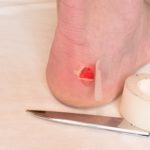 Blisters are usually caused by damage to the skin by physical damage or infection or illness. Generally, blisters can be self-treated and do not usually require medical attention. Blisters occur when the epidermis which is the upper layer of skin, tears away from the layer underneath and fluid collects in the space to create the blister.
Blisters are usually caused by damage to the skin by physical damage or infection or illness. Generally, blisters can be self-treated and do not usually require medical attention. Blisters occur when the epidermis which is the upper layer of skin, tears away from the layer underneath and fluid collects in the space to create the blister.
Blisters are caused by friction, skin reaction or medical conditions. Friction blisters are common with poorly fitting shoes, manual work, sports and outdoor pursuits. As the skin is rubbed, the blister forms which can be painful and uncomfortable.
Blisters caused by skin reactions are when the skin is exposed to excessive heat like burns or sunburn. It can also be when your skin comes in to contact with some chemicals.
There are many medical conditions where blisters can occur like, chickenpox, cold sores and foot and mouth disease.
Blisters can be painful and the sooner you treat them, the better the outcome. The treatment for blisters is to protect the blister using a plaster or special blister dressing. Do not burst the blister as the blister is there to protect the skin, so if you burst it, you will expose the unprotected skin which can cause infection and further damage. The blister will slowly reduce as the body absorbs the fluid in the blister and eventually the top skin will fall off.
If a blister has burst, allowing the fluid to drain out, wash with water and cover the blister with a sterile dressing.
You need to see a Doctor or Nurse if the blister is: very painful or if it gets infected, or if you keep getting new blisters, caused by sunburn, burns or scalds or an allergic reaction. In these cases, antibiotics are sometimes used to treat the infection.
Blood blisters should also be left to heal naturally. If the blood blister is painful the use of an ice pack for 10-30 minutes may help but be careful not to burn the skin with the cold.
Finally, prevention is better than cure so make sure your feet are dry and you have good fitting shoes. If you play sports or exercise regularly wear thicker wool socks and avoid new shoes that are not broken in. Gloves will protect your hands against blisters.
For more information on First Aid training courses visit ProTrainings website.
